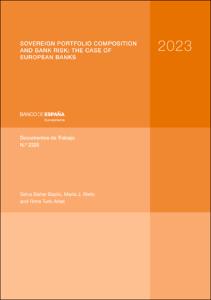Sovereign portfolio composition and bank risk: the case of European banks
Autor
Fecha de publicación
21-sep-2023
Descripción física
43 p.
Resumen
Este artículo amplía la literatura financiera sobre el nexo soberano-banco examinando los efectos de composición de las carteras de soberanos en el perfil de riesgo de los bancos, a diferencia de estudios anteriores que, generalmente, analizaban los determinantes de las carteras de soberanos de los bancos o los efectos del tamaño de estas carteras. También nos diferenciamos de estudios anteriores con respecto a las medidas de riesgo consideradas y al período de cobertura de nuestra muestra, que va mucho más allá de la crisis financiera mundial (2009-2018). Basándonos en datos granulares de la Autoridad Bancaria Europea, concluimos que los bancos asumen un riesgo más elevado cuando su cartera incluye una mayor proporción de valores emitidos por soberanos de mayor riesgo o cuando dichos bancos están domiciliados en un país con alto riesgo crediticio soberano. Pero no encontramos evidencia concluyente de que unas mayores tenencias de valores soberanos del país donde está domiciliado el banco aumenten el riesgo bancario ex post. Sin embargo, el perfil de riesgo es mayor para los bancos que recibieron inyecciones de capital del Gobierno que para aquellos que no recibieron apoyo de capital tras la crisis financiera mundial. Los bancos que recibieron inyecciones de capital del Gobierno tienen un menor perfil de riesgo cuando su cartera incluye una mayor proporción de valores emitidos por soberanos de mayor riesgo. Estos resultados pueden indicar que los motivos de arbitraje regulatorio en estos bancos son particularmente importantes.
We extend the literature on the sovereign-bank nexus by examining the composition effects of sovereign portfolios on banks’ risk profile, unlike previous studies which generally analyzed the determinants of banks’ sovereign portfolios or the size effects of these portfolios. We also differ from previous studies with respect to the measures of risk considered and by covering a sample period that goes well beyond the global financial crisis (2009-2018). Drawing on granular data from the European Banking Authority, we find that banks are riskier when their portfolio includes a higher proportion of securities issued by higher-risk sovereigns or when they are themselves domiciled in a country with high sovereign credit risk. Nevertheless, we do not find conclusive evidence that larger holdings of government securities of the country where the bank is incorporated increase bank risk ex-post. However, the risk profile is higher for banks that received government capital injections than for banks that did not receive capital support in the aftermath of the global financial crisis. Banks that received government capital injections are less risky when their portfolio includes a higher proportion of securities issued by higher-risk sovereigns. These results may indicate that regulatory arbitrage motives at these banks are particularly important.
We extend the literature on the sovereign-bank nexus by examining the composition effects of sovereign portfolios on banks’ risk profile, unlike previous studies which generally analyzed the determinants of banks’ sovereign portfolios or the size effects of these portfolios. We also differ from previous studies with respect to the measures of risk considered and by covering a sample period that goes well beyond the global financial crisis (2009-2018). Drawing on granular data from the European Banking Authority, we find that banks are riskier when their portfolio includes a higher proportion of securities issued by higher-risk sovereigns or when they are themselves domiciled in a country with high sovereign credit risk. Nevertheless, we do not find conclusive evidence that larger holdings of government securities of the country where the bank is incorporated increase bank risk ex-post. However, the risk profile is higher for banks that received government capital injections than for banks that did not receive capital support in the aftermath of the global financial crisis. Banks that received government capital injections are less risky when their portfolio includes a higher proportion of securities issued by higher-risk sovereigns. These results may indicate that regulatory arbitrage motives at these banks are particularly important.
Publicado en
Documentos de Trabajo / Banco de España, 2325
Materias
Bancos; Crisis soberana; Unión Europea; Banks; Sovereign crisis; EU; Regulación y supervisión de instituciones financieras; Sistemas bancarios y actividad crediticia; Instituciones crediticias de depósito; Países de la UE
Aparece en las colecciones:












